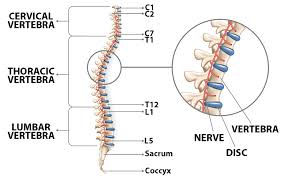by Oasis Wellness Partners on December 31, 2019

The spine is a complex system in the body–made up of 33 individual bones stacked on top of eac other –with spinal nerves that pass between them that supply the body with nerve function. In other words, the spine and nervous system allow you to move, think and feel! To allow mobility and make room for the spinal nerves, the vertebral bodies are separated by spinal discs. These discs are designed to resist force, resist slippage and still allow range of motion around each segment. However, injury to discs can occur (accidents, stress, the wear and tear of everyday life) and because of the complex nature of the structures that make up this area of the spine, symptoms can all look very different. We at Chiropractic Family Wellness Center believe that knowledge is power, so let us take you through the spine and areas that are often subluxated (or have high levels of nerve interference) so that you can see for yourself how it works and how you can feel and heal better:
C1,2 – This is the top two vertebra in the neck. These 2 ‘Cervical’ vertebra have nerves that supply important parts of the body: the Eyes, Ears, Scalp (Headaches), Pituitary Gland, Heart and Mouth. Due to its location, it is a very common to have problems with this part of the body. When stressed, people often report increased muscle tension in the upper cervical spine and shoulders and over time, this tension can become headaches, neck stiffness, arm pain and can relate to degenerative changes.
C7 is the lowest vertebra in the neck. Together with the T1 nerves, the heart, throat, esophagus, shoulders, arms, hands and fingers are controlled by this segment. It is a very common part of the body to have problems, especially if you spend a lot of the time sitting. As with C1, stressed people often report increased muscle tension in the upper cervical spine and shoulders.
T4 is the fourth vertebra in the upper back. The nerves branching from this area supply the Heart, Esophagus, Liver, Upper Arm, Gallbladder and Chest. The parts of your body supplied by T4 are crucial for a full expression of health. Ensuring that there is no interference to the nerve supply is part of an important strategy for optimal performance. Again, sitting and stress are the main causes of problems with this part of the body (are we seeing a pattern, here?).
T10 is the vertebra in the mid-back. This area of the spine supplies nerves and control for the intestines, large and small, the pancreas, the spleen, the stomach, legs, appendix and reproductive organs. Injuries to this part of the body can cause issues in areas of digestion, hormone control, general movement and control of blood chemistry (cholesterol, etc.).
L1-3 is a vertebra in the upper part of the lower back. This area of the spine supplies nerves and control for the large intestines, abdomen, reproductive organs, prostate, bladder, appendix and certain parts of the legs & feet. These are important parts of the body for digestion, reproduction, hormone control, general movement and elimination of waste from the body. This area is often damaged from too much sitting!
L4-S1 is a vertebra in the lower back. This area of the spine supplies nerves and control for the Prostate, Leg & Foot, Buttock, Muscles of Lower Back, Bladder and Anus. These are important parts of the body for digestion, reproduction, hormone control, general movement and elimination of waste from the body. Again, problems with this area are usually the result of too much sitting.
When you come to see the experienced chiropractors at Chiropractic Family Wellness Center in Scarborough, Maine, we will do a thorough spinal examination and scans to determine where the area of subluxation exist along your spine, and come up with a care plan of chiropractic adjustments to remedy it. If you want to learn about the well-being of your spine and how you can start to function at your best, call us to make an initial appointment at our chiropractic office in Southern Maine at (207) 883-5549.